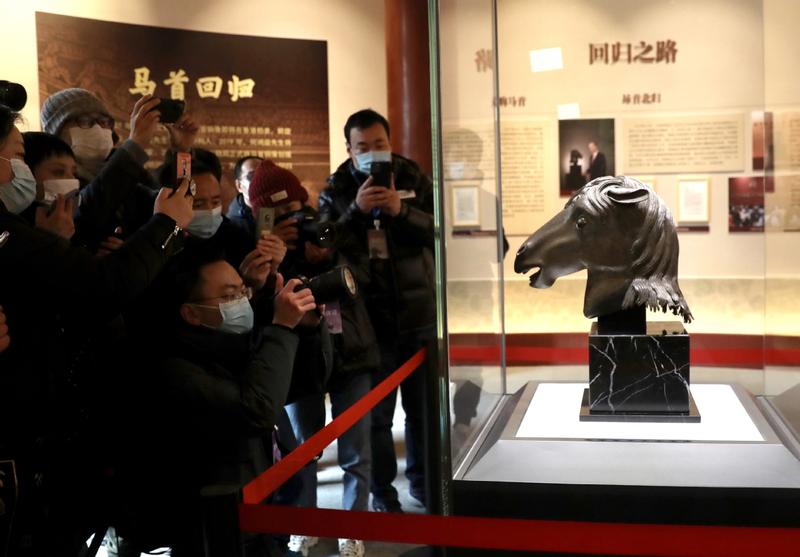 Visitors photograph a bronze sculpture of a horse's head, looted by invading Anglo-French forces 160 years ago, at Yuanmingyuan Park in Beijing after its return on Dec 1, 2020. (ZOU HONG / CHINA DAILY)
Visitors photograph a bronze sculpture of a horse's head, looted by invading Anglo-French forces 160 years ago, at Yuanmingyuan Park in Beijing after its return on Dec 1, 2020. (ZOU HONG / CHINA DAILY)
A famous bronze sculpture of a horse's head, which was looted in 1860 from the Old Summer Palace, or Yuanmingyuan, finally returned home on Tuesday to the site of the former imperial resort of the Qing Dynasty (1644-1911) in Beijing.
The object was one of 12 Chinese zodiac signs adorning a water-clock fountain that were stolen by invading Anglo-French forces in 1860 during the Second Opium War (1856-60).
Buildings were burned down and numerous cultural relics were looted in the turmoil 160 years ago, leading Yuanmingyuan to gradually fall into ruin.
The loss and return of this object tells us that the destiny of cultural relics is closely connected with that of the nation.
Liu Yuzhu, Director of the National Cultural Heritage Administration
Not only is the horse head the first of the 12 animal-head sculptures to be returned to Yuanmingyuan, but it is also the first important cultural relic from the Old Summer Palace to be returned to and housed at its original site after being repatriated from overseas, Xinhua News Agency reported.
It was bought by the late Macao business magnate and philanthropist Stanley Ho Hung-sun in 2007 and was donated to the National Cultural Heritage Administration in November 2019. It was recently transferred to the authorities responsible for the Yuanmingyuan ruins, also echoing Ho's wishes.
ALSO READ: Horse-head statue of Old Summer Palace comes home
"The loss and return of this object tells us that the destiny of cultural relics is closely connected with that of the nation," Liu Yuzhu, director of the National Cultural Heritage Administration, said at Tuesday's handover ceremony at Yuanmingyuan Park.
"It's no more a private royal collection, but heritage shared by all people," he said. "Better protection, study and display of the relic will show the inclusiveness and resilience of Chinese civilization."
"The horse's head holds the memory of history and our nation's shared emotion," Pansy Ho Chiu-king, Stanley Ho's daughter, said in a congratulatory video clip shown at the handover ceremony.
"It also reflects Hong Kong and Macao compatriots' attachment to the country."
READ MORE: Horse-head bronze statue returns to Old Summer Palace
Yuanmingyuan, which literally means "the garden of perfect brightness", was an estate of gardens, temples, palaces and pavilions spreading over 350 hectares-roughly the size of Central Park in New York-in the northwest of Beijing.
The horse's head was bought by the late Macao business magnate and philanthropist Stanley Ho Hung-sun in 2007 and was donated to the National Cultural Heritage Administration in November 2019
Construction of Yuanmingyuan began in 1707 during the reign of Kangxi (1661-1722), and it was expanded and renovated during the reigns of the next five emperors.
Yuanmingyuan continued to function as a major royal residence until 1860, as emperors spent much time living there due to the more comfortable environment than the Forbidden City.
From 1747 to 1760, the European-style Western Mansions area (Xiyang Lou) was constructed in Yuanmingyuan, featuring a combination of Chinese and Western craftsmanship. The fountain, with 12 animal-head statues, from which water poured to mark the passing of every two hours, was a highlight in this area.
As the original fountain is in ruins, the horse's head is being displayed in a pavilion within the Zhengjue Temple compound of Yuanmingyuan together with details of how it got lost and was returned.
READ MORE: Statue to return to former royal resort after 159 years
A number of relics, old photos and models depicting the ancient glory of Yuanmingyuan are also on display at the temple.
Zhengjue Temple is one of few sites at Yuanmingyuan that generally remains intact. It was recently refurbished at a cost of 10 million yuan (US$1.52 million), which was allocated by the government of Haidian district, where Yuanmingyuan is located.
"The return of the sculpture also sets an example for the international community to bring more lost relics back to their origins," Liu said.
Seven of the 12 sculptures have so far been returned to China. In addition to the horse's head, the other six are also in Beijing, at the National Museum of China and the Poly Art Museum.


